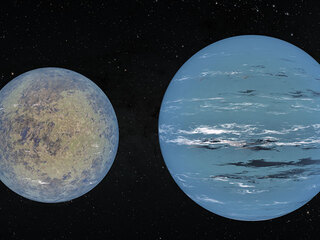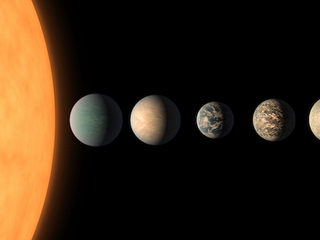News | December 15, 2005
Planet Hunters: Burning the midnight oil at 13,600 feet

Robert Ligon
Robert Ligon is an engineer, not an astronaut. Nonetheless, his work takes place on an otherworldly landscape miles above sea level, where the air is thin and clear. He is part of a team that is pushing the technology envelope to aid in NASA's search for new worlds.
As optical engineer for the Keck Interferometer project, Ligon travels to Hawaii about nine times a year, where he helps keep a complex, multi-faceted system of optics working smoothly during all-night observing runs at the Keck Observatory. The work is conducted in the rarefied atmosphere atop Mauna Kea, a dormant volcano rising more than 13,600 feet above the Pacific Ocean.
The Keck Interferometer links the world's two largest optical telescopes to create a virtual telescope of unprecedented power, capable of probing regions around nearby stars where Earthlike planets may have formed. The project is managed by the Jet Propulsion Laboratory for NASA's Science Mission Directorate.
Robert was born in Hawaii and received his M.S in optical sciences from the University of Arizona in 1996.
PlanetQuest: Please describe your role in NASA's planet-finding program.
Robert Ligon: I help design and build all the optical subsystems on the Keck Interferometer project. This includes trouble-shooting, getting them to work together, and achieving good image quality.
PQ: How did you get started in this field?
Ligon: I was returning to school at the University of Arizona, and a friend suggested I take an optical engineering class with him and try it out. I found out that physical optics is a lot like electrical engineering, except you can actually see things, like the interference of light. I was hooked, and I ended up getting my degree from there.
PQ: Were you interested in this kind of thing when you were young?
In his spare time, Ligon is an avid skin diver and underwater photographer. He snapped this image of a green turtle off the big island of Hawaii in August 2004.
Ligon: When I was a kid I loved taking things apart. Sadly, I wasn't as good putting them back together again. That was the one thing my parents didn't like. But I was really an outdoors person, and I think that's what linked me to optics. It was a way to exercise my brain while still connecting to nature.
PQ: Is there a particular teacher who influenced you along the way?
Ligon: Yes, Professor James Palmer, my radiometry teacher at the University of Arizona. He was a lab rat, very good at enjoying the lab, but also good at enjoying the rest of his life. He was a singer in a choir that traveled quite a bit, and he did a lot of interesting things outside of the lab. He was really good at teaching me to have balance in my life.
PQ: What do you like to do in you spare time?
Ligon: I like to be outdoors. When I'm not working, I'm usually at the beach or in the mountains, every single weekend.
PQ: What advice would you give to a young person considering a similar career?
Ligon: If someone was going into the engineering field, I would suggest to them to just do something they love, because engineering encompasses a lot. People may think that engineers just twiddle things and tinker, but there are a whole lot of different subsets of engineering that have to do with business, procurement and other aspects. Engineers have to be more well-rounded than a lot of people realize.
PQ: What has been your favorite moment working on the project?
Ligon: When we first started working on the project on the summit, we worked constantly. Every single night we were up on the summit debugging the system. It was a big ordeal for us. So when we were ready for our first night using the giant Keck telescopes, everybody was kind of bunkered down for a very long night. And it ended up that we locked on the stars, and within five minutes we got our first fringes (interference patterns). It was really a great moment.
PQ: What's the coolest part of what you do?
Ligon: The coolest part of optical engineering is the visual-ness of it. You can see the waves, but you don't need an oscilloscope. Just by looking at the interference of optical beams you get an understanding of what the equations are doing. And these are the kind of effects that can be seen everywhere in the world in rainbows, oil slicks on water, or with sun dogs. There are so many optical effects in nature -- it's incredible to learn about the science behind that.








